#prehistoric pottery
Text
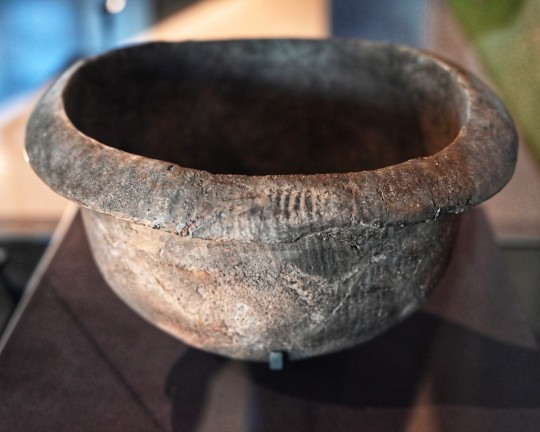




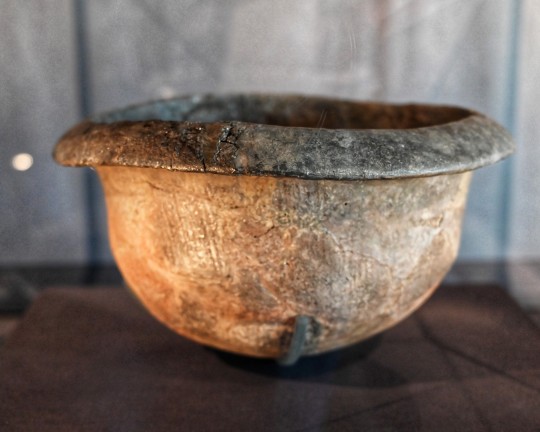
Prehistoric Food Vessel from Nether Largie South Chambered Cairn, 5000 years old, Kilmartin Museum, Kilmartin Glen, Argyll, Scotland
#ice age#stone age#bronze age#copper age#iron age#neolithic#mesolithic#calcholithic#paleolithic#prehistoric#prehistory#chambered cairn#cairn#grave goods#ritual#archaeology#vessel#pottery#prehistoric pottery#relic#kilmartin glen#nether largie south cairn
195 notes
·
View notes
Text

The death of Prince Terasarin of Sartar, who "was killed when a stray moonbeam blinded him as he climbed a cliff to escape a hungry dinosaur."
#artists on tumblr#fantasy#illustration#glorantha#runequest#fantasy art#dinosaurs#paleoart#red figure pottery#came across that line while referencing King of Sartar for a commission and just had to draw it#the dinosaur is based on the t.rex from prehistoric planet because that show is amazing
841 notes
·
View notes
Text

Ornamented pottery in the "Fire Flame" style, dating to the Middle Jomon period (ca. 2500-1500 BCE). Found at Sasayama, Niigata Prefecture, Japan; now in the Tokyo National Museum.
#art#art history#ancient art#prehistoric art#prehistory#Japan#Japanese art#East Asia#East Asian art#Jomon#Jomon period#pottery#ceramics#Tokyo National Museum
599 notes
·
View notes
Photo


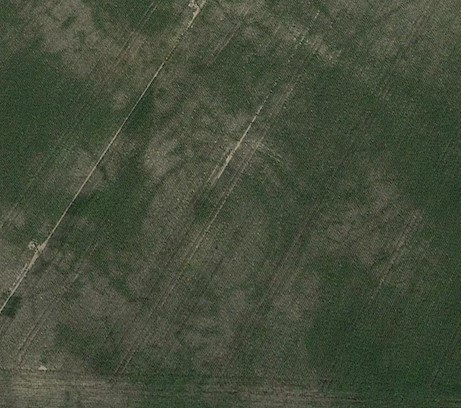

polish roundels (aka circular neolithic enclosure in Central Europe)
Drzemlikowice, Oława, Tylice, Nowe Objezierze
#neolithic#prehistory#stone age#archaeology#prehistoric europe#rondels#roundels#neolithic circular enclosures in central europe#stroked pottery culture#lengyel culture#earthworks#central europe#poland#archeology#my upl
102 notes
·
View notes
Text


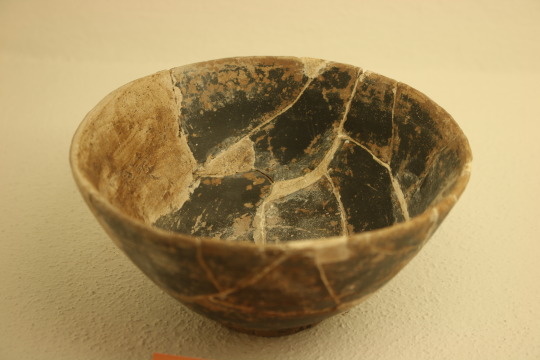
Museo de Artà, Mallorca, 07-12-23
#Artà#Mallorca#07-12-23#prehistory#tw: bones#bones#prehistoric#archeology#ancient history#photography#photo#photographers on tumblr#aesthetic#aesthetics#illes balears#pottery#museum#museum artifacts#artifacts
3 notes
·
View notes
Text
Gathered in an exhibition room at Stonehenge, around 80 objects made in Japan during the Jōmon period, roughly the same time the great stone circle on Salisbury Plain was built, highlight some beguiling parallels between two cultures separated by thousands of miles.
The exhibition, Circles of Stone: Stonehenge and Prehistoric Japan, reveals that prehistoric people in southern Britain and in Japan took great trouble to build stone circles, appear to have marked and celebrated the passage of the sun and felt moved to come together for festivals or rituals.
“Of course they couldn’t possibly have any idea what each other was doing,” said Martin Allfrey, senior curator for English Heritage. “But it is tantalising to look at what these extraordinary objects from Japan tell us about the similarities between these communities who were perhaps ideologically closer than one might imagine. Exploring what is happening elsewhere in the prehistoric world is key to understanding the significance of Stonehenge.”
At about the time Stonehenge’s builders were creating the monument, their Japanese counterparts were coming together to make sites such as the Ōyu stone circles in northern Japan. These do not feature the sort of hulking standing stones that Stonehenge is famous for but rather large circles made of thousands of river pebbles. Like Stonehenge, they appear to be aligned to mark solstices.
Star of the show at Stonehenge is the Jōmon cooking pot, which Simon Kaner, executive director of the Sainsbury Institute for the Study of Japanese Arts and Cultures, explained would have been placed in the fire of a Jōmon dwelling near the Shinano River. He pointed out the black marks that show it was used for making, perhaps, a fish stew. “Imagine sitting around the fireplace as a meal bubbled away in this. It must have cast the most extraordinary shadows,” he said. This is the first time the pot has gone on display outside Japan.
Finds made at the Japanese stone circles suggest people came together for feasts and venerated their ancestors, just like the people who constructed Stonehenge. The scale of their creations meant that both the ancient Britons and Japanese people must have been able to bring together large numbers of people to co-operate on ambitious, important projects.
Geography may have something to do with the parallels. The UK and Japan flank the Eurasian landmass at roughly the same latitude, meaning they have similar climates and natural resources, which both peoples exploited and adapted.
#love jomon pottery#that header image is causing me to short circuit#they took the pot on a fieldtrip to Stonehenge!!#prehistoric japan#neolithic Britain#ancient cultures#ancient history#exhibitions
13 notes
·
View notes
Text
WOW.
Scientists found an amazingly well-preserved village from 3,000 years ago
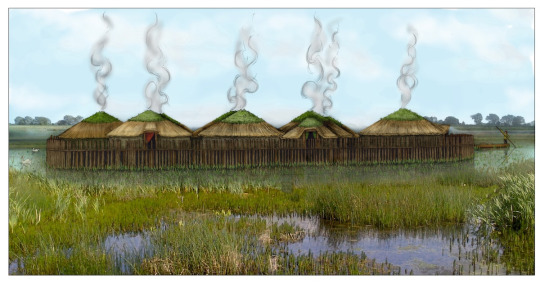

Text below, in case article access dries up:
LONDON — A half-eaten bowl of porridge complete with wooden spoon, communal rubbish bins, and a decorative necklace made with amber and glass beads are just a handful of the extraordinarily well-preserved remnants of a late Bronze Age hamlet unearthed in eastern England that’s been dubbed “Britain’s Pompeii” and a “time capsule” into village life almost 3,000 years ago.
The findings from the site, excavated in 2015 to 2016, are now the subject of two reports, complete with previously unseen photos, published this week by University of Cambridge archaeologists, who said they cast light onto the “cosy domesticity” of ancient settlement life.
“It might be the best prehistoric settlement that we’ve found in Britain,” Mark Knight, the excavation director and a co-author of the reports, said in an interviewThursday. “We took the roofs off and inside was pretty much the contents,” he said. “It’s so comprehensive and so coherent.”
The reason for the rare preservation: disaster.
The settlement, thought to have originally consisted of several large roundhouses made of wood and constructed on stilts above a slow-moving river, was engulfed by a fire less than a year after being built.
During the blaze, the buildings and much of their contents collapsed into a muddy river below that “cushioned the scorched remains where they fell,” the university said of the findings. This combination of charring from the fire and waterlogging led to “exceptional preservation,” the researchers found.
“Because of the nature of the settlement, that it was burned down and its abandonment unplanned, everything was captured,” Knight added.
“As we excavated it, there was that feeling that we were picking over someone else’s tragedy,” he said of the eerie site in the swampy fenland of East Anglia. “I don’t think we could smell the fire but the amount of ash around us — it felt close.”
Researchers said they eventually unearthed four large wooden roundhouses and an entranceway structure, but the original settlement was probably “twice as big.”
The site at Must Farm dates to about 850 B.C., eight centuries before Romans came to Britain. Archaeologists have been shocked at “just how clear the picture is” of late Bronze Age life based on the level of detail uncovered, Knight said.
The findings also showed that the communities lived “a way of life that was more sophisticated than we could have imagined,” Duncan Wilson, head of Historic England, the public body responsible for preserving England’s historic environment, said in a statement.
The findings unearthed include a stack of spears, possibly for hunting or defense; a decorative necklace “with beads from as far away as Denmark and Iran”; clothes of fine flax linen; and a female adult skull rendered smooth, “perhaps a memento of a lost loved one,” the research found.
The inhabitants’ diet was also rich and varied, including boar, pike and bream, along with wheat and barley.
A pottery bowl with the finger marks of its maker in the clay was also unearthed, researchers said, still containing its final meal — “a wheat-grain porridge mixed with animal fats” — with a wooden spatula resting inside the bowl.
“It appears the occupants saved their meat juices to use as toppings for porridge,” project archaeologist Chris Wakefield said in the university’s news release. “Chemical analyses of the bowls and jars showed traces of honey along with ruminant meats such as deer, suggesting these ingredients were combined to create a form of prehistoric honey-glazed venison,” he added.
Skulls of dogs — probably kept as pets and to help with hunting — were also uncovered, and the dogs’ fossilized feces showed they fed on scraps from their owners’ meals, the research found.
The buildings, some connected by walkways, may have had up to 60 people living there all together, Knight said, along with animals.
Although no intact sets of human remains were found at the site, indicating that the inhabitants probably fled the fire safely, several sheep bones were found burned indoors. “Skeletal remains showed the lambs were three to six months old, suggesting the settlement was destroyed sometime in late summer or early autumn,” according to the university’s news release.
Ceramic and wooden vessels including tiny cups, bowls and large storage jars were also found. Some pots were even designed to nest, stacked inside one another, Knight said — evidence of an interest in aesthetics as well as practicality.
A lot of similar items were found replicated in each home, Knight added, painting the picture of completely independent homesteads for each family unit rather than distinct buildings for shared tasks — much like we live today.
Household inventories often included metal tools, loom weights, sickles for crop harvesting, axes and even handheld razors for cutting hair.
The roundhouses — one of which had almost 50 square meters (nearly 540 square feet) of floor space — had hearths and insulated straw and clay roofs. Some featured activity zones for cooking, sleeping and working akin to modern-day rooms.
The Must Farm settlement has produced the largest collection of everyday Bronze Age artifacts ever discovered in the United Kingdom, according to Historic England, which partly funded the 1.1 million pound ($1.4 million) excavation project.
The public body labeled the site a “time capsule,” including almost 200 wooden artifacts, over 150 fiber and textile items, 128 pottery vessels and more than 90 pieces of metalwork. Some items will go on display at the nearby Peterborough Museum next month.
Archaeologists never found a “smoking gun” cause for the fire, Knight said. Instead, they suspect it was either an attack from “outside forces,” which may explain why the inhabitants never returned to collect their possessions from the debris, or an accidental blaze that spread rapidly across the tightly nestled homes.
“Probably all that was left was the people and what they were wearing; everything else was left behind,” Knight said of the fire.
But the preservation has left a window for people to look back through in the future. “You could almost see and smell their world,” he said.
“The only thing that was missing was the inhabitants,” Knight added. “And yet … I think they were there — you certainly got glimpses.”
2K notes
·
View notes
Text

Unknown, Northwest China, Neolithic period, Majiayao culture, Majiayao phase (3300-2650 BC)
Jar with Spiral Designs
Ceramic earthenware
This jar is a spectacular example of painted pottery from the Majiayao culture, one of the regional cultures of prehistoric China. Its geometric patterns are probably abstract symbols transformed from a bird image, which may suggest a clan totem or nature spirits. Archaeological work confirms the coexistence of different regional cultures in ancient China, contesting the old belief that the Chinese civilization originated solely along the Yellow River. The artifacts of these cultures manifest distinctive characteristics; each one played a role in the formation of the greater Chinese civilization.
Cleveland Museum of Art
179 notes
·
View notes
Note
I’m just wondering if you will be making more of those amazing prehistoric ceramic horses. I need to buy some!

These buddies?! Heck yeah! A herd of 13 just went into their glaze firing this morning :)



I'm not 100% sure when the next shop update will be (I've got some busy times coming up with other non-pottery projects), but I'll hopefully get my butt in gear sometime in the next few weeks!
#artblog#pottery#ceramics#handbuiltceramics#ceramicart#ceramicsculpture#handbuilding#ask#ask answered
149 notes
·
View notes
Text
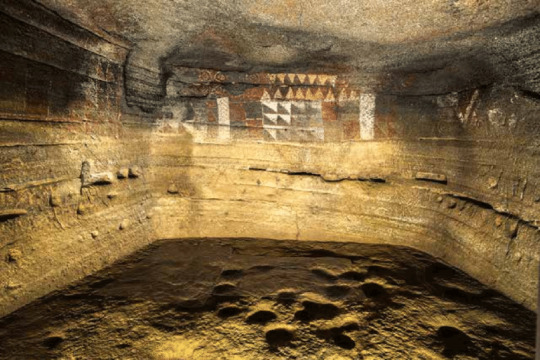

The prehistoric Cueva Pintada (Painted Cave) located on the island of Grand Canary in the Canary Islands archipelago. The cave was discovered by accident in 1862 during agricultural digging work. When it was first found, it contained skeletons, pottery and other utensils. The paintings themselves consist of precisely delineated geometrical patterns painted in ochre, a pigment derived from minerals. Archaeologists think that, due to their regular distribution (usually in series of twelve), they could be a sort of calendar. They were created by the Canarii, the indigenous inhabitants of the island prior to the Spanish invasion in the 15th century. The Canarii (also known as the Guanche) were of North African origins, and genetic testing of their mummies found they were closely related to Moroccans, Berbers and Spaniards.
The first carbon-14 analysis made on the cave was on the wall paintings. This gave no results because the paint used carried no trace of carbon, being entirely non-organic. Some vegetal remains of a plant from the family Lauraceae were found in the mortar in the walls. These remains were dated between 1049 and 1257 BCE. Some fragments of pine wood were dated between 601 and 994 CE.
67 notes
·
View notes
Text
For #NationalTeaDay 🫖☕���:


Teapot with Fossil Decoration
British, Staffordshire, c. 1760–65
Salt-glazed stoneware with enamel decoration
4 1/4 × 7 1/4 in. (10.8 × 18.4 cm)
The Metropolitan Museum of Art, New York 37.22.6a,b
“Though it's got a surprisingly modern look, this teapot was made in the 18th-century in Staffordshire—the heart of Britain's pottery industry. The area’s limestone yielded prehistoric fossils, and potters often turned them into whimsical motifs for teapots.”
#animals in art#european art#British art#decorative arts#ceramics#Staffordshire#pottery#teapot#National Tea Day#tea kettle#monochrome#black and white#fossil#fossils
64 notes
·
View notes
Text

Iron Age Pottery Fragment with Deer Designs, Dun Borbaidh and Kilpheder, First to Fourth Century CE, The National Museum of Scotland, Edinburgh
#ice age#stone age#bronze age#copper age#iron age#neolithic#mesolithic#calcholithic#paleolithic#prehistoric#prehistory#prehistoric pottery#deer#archaeology#design#ancient craft#ancient cultures#ancient living#animals#fauna
187 notes
·
View notes
Photo

The Sweet Track
The Sweet Track is a Neolithic timber walkway, located in the Somerset Levels, England. It was originally part of a network of tracks built to provide a dry path across the marshy ground. The Sweet Track ran between what was then an island at Westhay to a ridge of high ground, close to the River Bruce. The remains of mounds have also been found at Westhay, indicating the remains of a settlement.
About 1.6 kilometres (1 mile) long, the Sweet Track was discovered in the 1970s CE during a peat excavation by Ray Sweet, (who also gave the track its name). Using dendrochronology (tree-ring dating) the track has been dated 3807/3806 BCE. For many years it was thought to be the oldest trackway in Northern Europe, until 2009 CE when a slightly older one was discovered in Plumstead, London.
The Somerset Levels are an area of wetlands and peats. The conditions of such areas can naturally lead to the preservation of organic materials. Materials become encased in a wet and airless environment, thus preventing, to a degree, decomposition. Wooden artefacts and structures have been recovered from the Levels, as well as the two well-preserved Iron Age villages of Glastonbury and Meare.
The track would have been built by a community of Neolithic farmers living in small settlements. Farming had spread from the Middle East and by this point was firmly established in Britain. According to pollen evidence, the whole of Britain would have been covered in forests at this time. The Neolithic peoples would have burnt and cleared the forests to have the land on which to grow their crops, mostly grains. A fair degree of organization is evident in the stockpiling of wood and construction of the tracks, and some members of the community would have had to have skills in woodworking. Using stone and flint axes, the trees for the track were cut on dry land with different cutting techniques used, depending on their age. Older oaks were cut vertically whilst younger trees tangentially. Modern research has been carried out using replica axes and the cut marks have also been studied to establish the methods of cutting used. The planks of wood were put together in the marsh, the final construction taking about a day to complete. Long poles were driven slantwise into the ground and then planks were laid in between, held in place by vertical pegs. The planks were made of oak, ash and lime. The poles and pegs were made mainly of hazel and alder. There are also remains of another track, known as the “Post Track”, which dates 30 years earlier than the Sweet Track, 3838 BCE. It ran roughly parallel to the Sweet Track, possibly used by the builders of the Sweet Track as an access route.
Artefacts have been found beside the track, among them, pottery and axe heads including one made of jadeite. Whether they had been deliberately buried, perhaps as an offering, or just lost, remains unknown. There have been many Prehistoric trackways found in England, but more than half reside in Somerset. Included in these are the Abbot's Way, Eclipse, Honeygore, Meare Health and Garvins tracks. They were constructed using varying styles, such as corduroy - laying short logs parallel to each other and side by side. The Sweet Track is the most well-known of these. It has been declared a scheduled monument (of national importance). Most of it remains in its original location and requires constant conservation to keep the wood in its damp condition. There are reproductions and a donated section now resides in the British Museum, London.
Continue reading...
33 notes
·
View notes
Text


Rare Coins and Treasures Discovered at Greece’s Ancient City of Tenea
Archaeologists in Greece discovered a hoard of rare ancient coins and other treasures at the ruins of Tenea, near Corinth, a city that was built by Trojan prisoners of war.
The Ministry of Culture announced on Tuesday that the recent excavation unearthed 29 silver ancient Greek coins dating from the late 6th century.
Several are among the rarest and most historic coins of ancient Greece, the ministry says.
Rare silver coins unearthed at Tenea
They include three staters of Elis minted at Olympia during different Olympic Games, staters of Aegina with a land instead of a sea turtle, staters of Stymphalos, Argos and Opuntia Lokron, as well as staters of Thebes from the 5th century BC depicting Hercules suffocating two snakes with his hands.
The stater, as a Greek silver currency, first as ingots, and later as coins, circulated from the 8th century BC to AD 50. The earliest known stamped stater (having the mark of some authority in the form of a picture or words) is an electrum turtle coin, struck at Aegina that dates to about 650 BC.
The treasure is linked to the finds of cult use (female and animal figurines, miniature vases and others) that were identified last year and continued to be identified this year, giving a clear ritual character to the areas that are revealed the announcement says.


Other stunning discoveries
The excavations at Tenea also revealed a section of Hadrian’s aqueduct, determining the course of one of the largest hydraulic works of the 2nd century. A.D. in Greece.
Also, part of the prehistoric settlement of Tenea, dating to the Early Bronze Age II (2,600 – 2,300 BC), was identified and excavated, confirming the area’s habitation before the fall of Troy.
In addition, a rich building complex from the late Archaic times to the Hellenistic times was revealed, with individual areas of cult use between them and three extremely well-maintained tanks, one of them with a descending-ascending scale.
The new excavations brought to light dozens of ancient pots and figurines.


The ancient city of Tenea in Greece discovered in 2018
According to Greek mythology, Tenea was established by Trojan prisoners of war who were granted permission by King Agamemnon to build their own settlement after the Trojan War.
The city’s location, roughly 15 kilometers (9.3 mi) southeast of Corinth and 20 kilometers (12 mi) northeast of Mycenae, made it an important crossroads for trade and communication.


In 2018, a team of Greek archaeologists led by Eleni Korka made a remarkable discovery: the remains of ancient Tenea, previously thought to be a mythical city.
The first excavations revealed a vast necropolis, or cemetery, dating back to the 4th century BC to the Roman era. Among the unearthed artifacts were jewelry, coins, and pottery shards, providing valuable insights into the city’s history and culture.
By Tasos Kokkinidis.

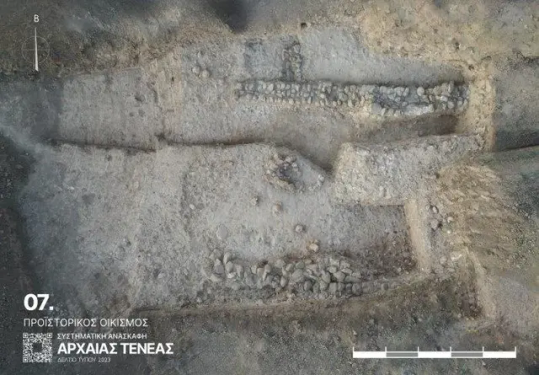
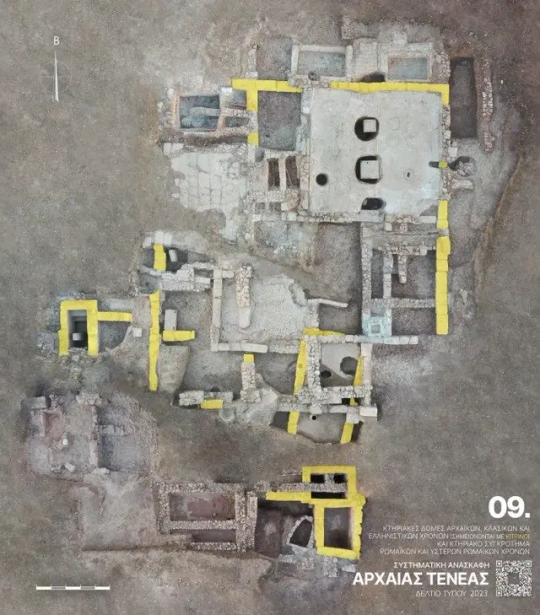
#Rare Coins and Treasures Discovered at Greece’s Ancient City of Tenea#Greece’s Ancient City of Tenea#silver#silver coins#ancient coins#ancient artifacts#archeology#archeolgst#history#history news#ancient history#ancient culture#ancient civilizations#ancient greece#greek history#greek art
48 notes
·
View notes
Photo
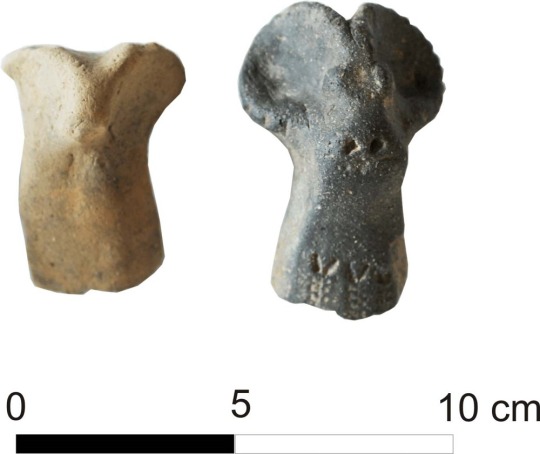
clay heads of rams from Lublin – Sługocin site
Funnelbeaker culture
3900–2800 B.C
phot. Jacek Jeremicz
#funnelbeaker culture#neolithic#prehistory#archaeology#artefact#prehistoric europe#ram#zoomorphic figurine#animals#pottery#stone age#my upl
1 note
·
View note
Text
Spanning from approximately 5500 BC to 2750 BC, the Trypillia Culture flourished in Eastern Europe during the Neolithic and Chalcolithic periods. Renowned for its rich cultural and material legacy, the Trypillia Culture left behind a profound imprint on the landscape of prehistoric Europe.
At the heart of this civilization lies a tapestry of intriguing symbols, intricate pottery, and advanced urban planning. Its expansive settlements, stretching across present-day Ukraine, Moldova, and Romania, reveal the complexity of Trypillia society.
25 notes
·
View notes